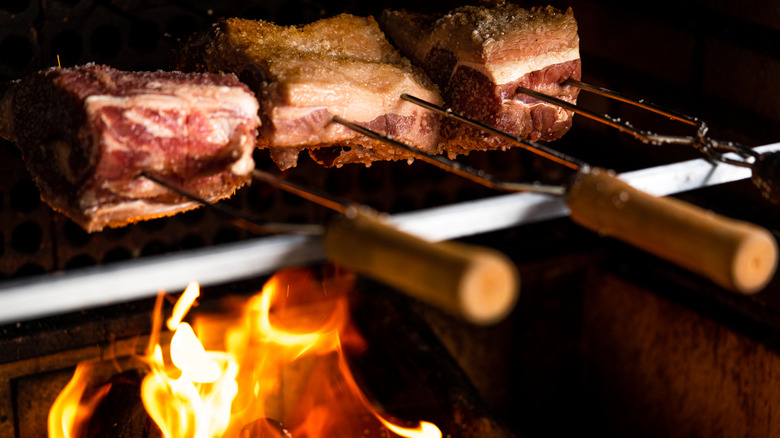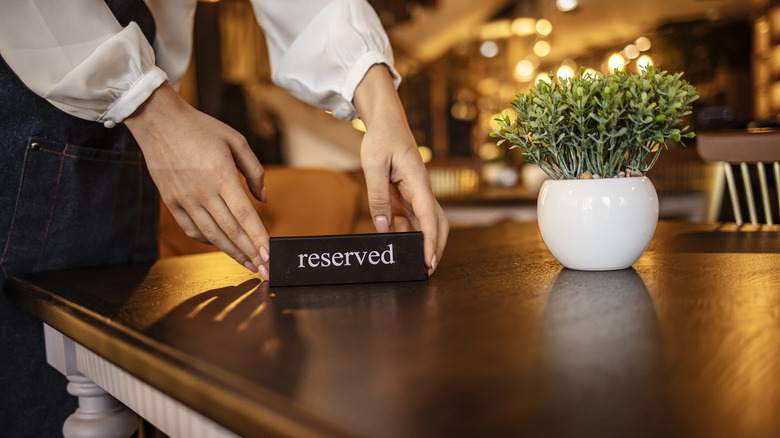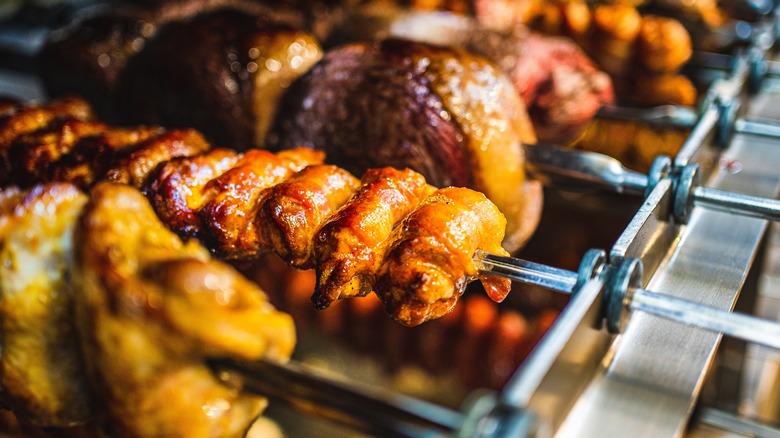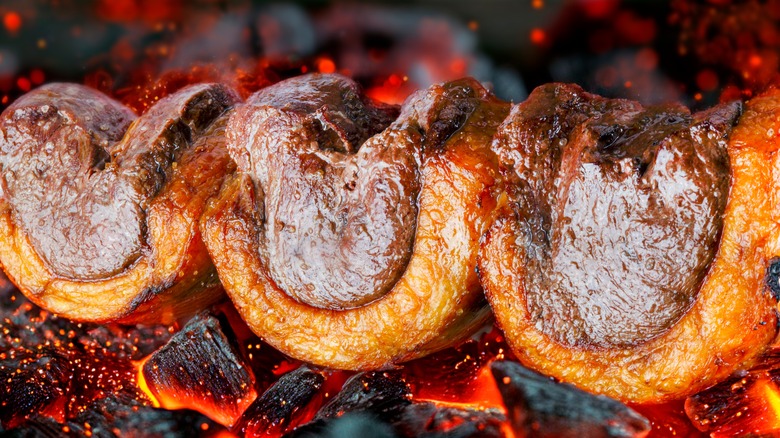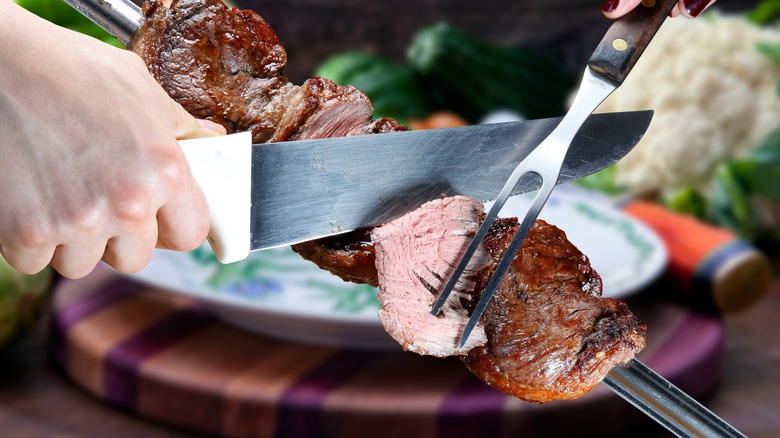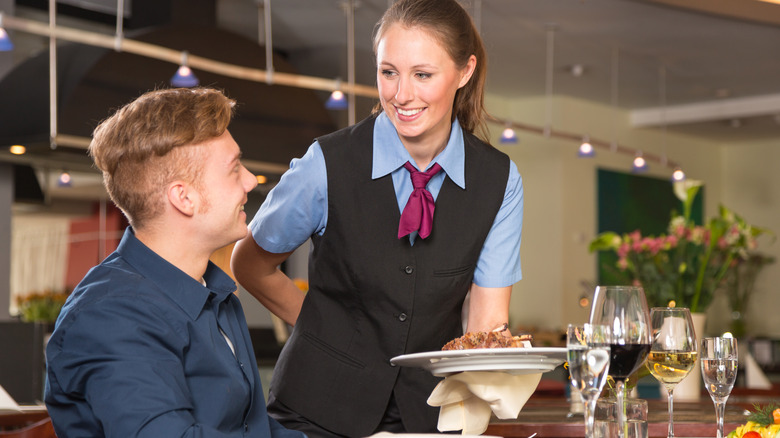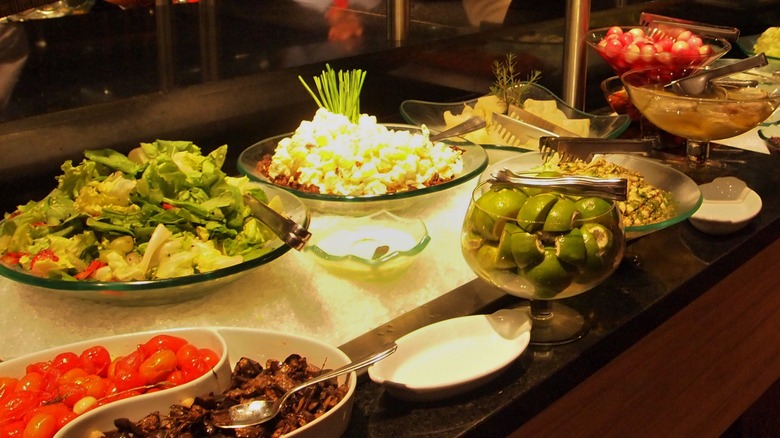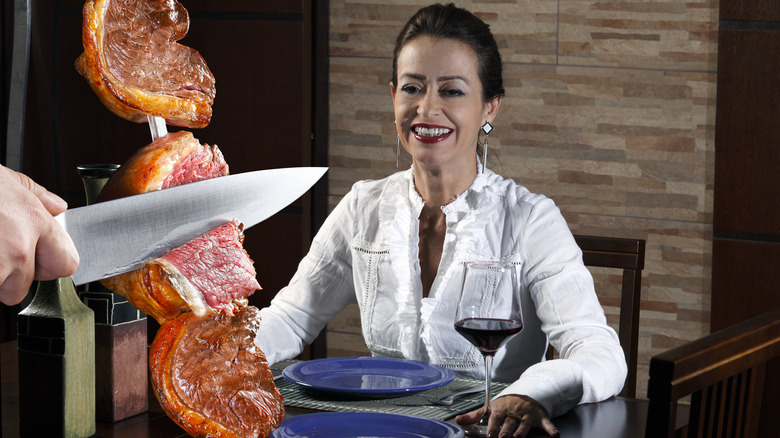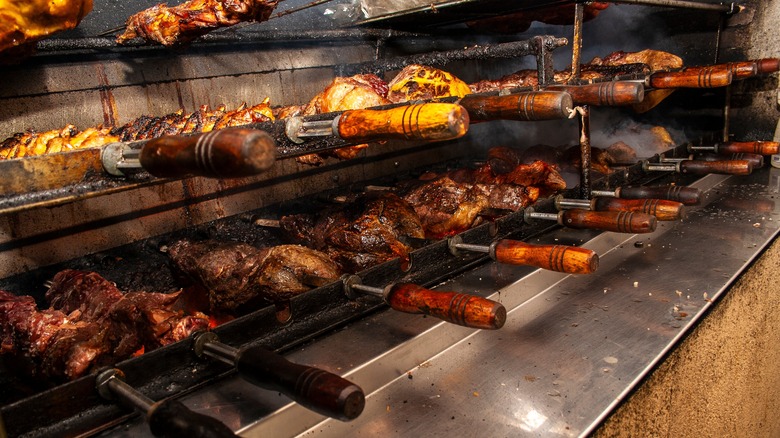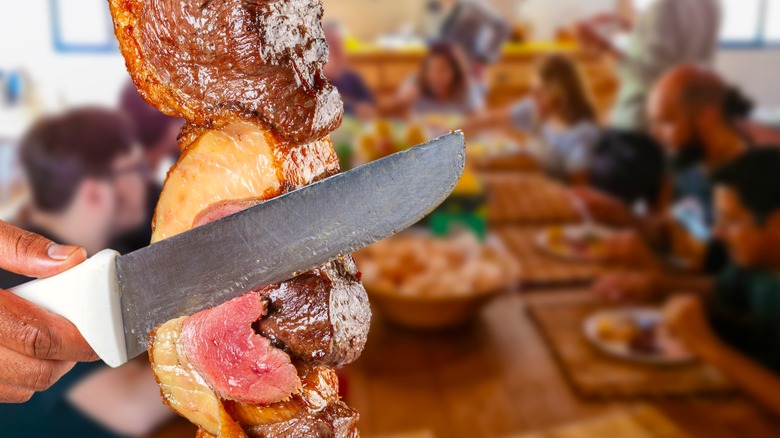How To Navigate Your First Trip To A Brazilian Steakhouse
If you've never been to a Brazilian steakhouse before, the experience can be a little overwhelming, but also worthwhile. This is because Brazilian steakhouses operate a little differently than traditional American steakhouses. Instead of ordering one entree for your meal, you have the opportunity to sample a variety of different grilled and roasted meats. You typically stay seated while servers bring the different cuts of meat to your table, and you can accept or decline whatever you wish. It's a pretty simple system, but the unique serving style can be confusing for newcomers.
There are multiple Brazilian steakhouses in the U.S., and while they're all a little bit different, most operate the same way. This makes it easy to know what to expect if you've been to a Brazilian steakhouse before, but I remember how out-of-sorts I felt the first time I visited one. To boost your confidence and familiarize yourself with the experience, here is a basic guide to help you navigate your first trip to a Brazilian steakhouse.
Make a reservation
Customers don't just go to Brazilian steakhouses for the amazing food, but also for the classy ambiance and welcoming atmosphere. As a result, these restaurants are usually pretty busy, especially during peak meal times. If you're planning ahead, you're going to want to make a reservation.
Although most Brazilian steakhouses will take walk-ins if they can, the truth is it isn't always possible for walk-ins to get a table. Fogo de Chão says that, "While reservations are not mandatory, we highly recommend making them in advance, particularly for weekends and holidays." Texas de Brazil says something similar, stating that, "Reservations are not required but we do highly recommend making a reservation."
While you're planning out your reservation, it helps to check the dress code. Brazilian steakhouses are not typically black-tie, but they do expect guests to dress appropriately. Chains like Fogo de Chão, Texas de Brazil, and Rodizio Grill recommend "smart casual" attire. Higher-end Brazilian steakhouses – especially ones that aren't part of a chain – may have a stricter dress code in place.
Keep in mind that due to the way Brazilian steakhouses work, you'll probably be dining there a little longer than you would at a standard steakhouse or other type of sit-down restaurant. Expect to spend one to two hours eating so you can sample the various cuts, and make sure to pay enough for parking so you don't have to feed the meter while eating!
Understand the different menu options
The highlight of Brazilian steakhouses is always the rotation of different meats. While menus vary between restaurants, you're likely to find cuts of chicken, lamb, pork, steak, and sometimes even seafood like shrimp or fish. There are often multiple cuts of each type of meat – many restaurants offer bacon-wrapped chicken or steak, parmesan-crusted chicken, or specialty Brazilian cuts, for example.
Most Brazilian steakhouses also include a salad bar in the experience. Again, salad bar options can vary, but you'll typically find gourmet salads, fresh vegetables, and imported cheese and other charcuterie options. Many also offer classic Brazilian options like grilled pineapple and traditional Brazilian stew. Sometimes, hot sides like mashed potatoes and rice are included with the salad bar.
In addition to the salad and meat, many Brazilian steakhouses offer side dishes, desserts, and handcrafted drinks. Some – like Fogo de Chão – also offer a la carte entrees if you're not in the mood for endless steak and meat. These can often be ordered instead of the parade of meat cuts. Alternatively, you can order an entree in addition to your meal if you're feeling extra hungry or just want something to take home.
Learn the terminology
Brazilian steakhouses are steeped in Brazilian culture. As a result, they use a lot of Brazilian words that can be confusing to those who don't speak the language. By learning what each term means, you'll have an easier time navigating your first trip to a Brazilian steakhouse.
Some Brazilian steakhouses refer to themselves as a "churrascaria," which is essentially the Brazilian term for restaurants that cook meat using a rotisserie style of cooking. Many – but not all – churrascarias serve their food "rodizio" style, meaning servers bring huge skewers of meat around and cut slices off right at your table. Those servers are often called "gauchos," a term that originally referred to traditional Brazilian cowboys, although some restaurants refer to these servers as "passadors."
Many Brazilian steakhouses also refer to certain cuts of meat by their Brazilian names. "Picanha" refers to top sirloin capped with a layer of fat, while "alcatra" is used to describe a large, long cut of top sirloin. "Fraldinha" is another term for flank steak, and "maminha" is a tri-tip steak. Your restaurant may also serve "linguiça," or pork sausage, and "cordeiro," a cut of lamb marinated in lemon and mint.
Expect to pay a prix-fixe, or a fixed price
"Prix-fixe" is a French term that translates to "fixed price." This essentially means that diners pay one flat price for their whole meal, no matter how much they eat. Most Brazilian steakhouses use prix-fixe pricing, which usually includes the rodizio meal, the salad bar, and nonalcoholic drinks. However, it's helpful to understand what all is included before you dine, as some restaurants also include side dishes, and others don't include drinks at all.
Many Brazilian restaurants offer a few options in addition to the fixed pricing. Fogo de Chão, Texas de Brazil, and Rodizio Grill allow diners to just eat at the salad bar, for example. This is a great option for those who are vegetarian, vegan, or have an allergy or intolerance to the rodizio ingredients. Add-ons like appetizers, desserts, and drinks are often available for a fee, as are individual entrees (if the steakhouse offers them).
There are a few other things you may want to consider when it comes to price as well. Often, kids eat for a reduced price, and at some restaurants, kids under a certain age eat for free. There is often also a price difference between lunch and dinner, so if you're on a budget, visiting for lunch may be a better option. Finally, gratuity is not usually included in the prix-fixe total, so plan accordingly!
Listen to instructions
At most Brazilian steakhouses, there's a method to help ensure that customers get as much rodizio as they like. Restaurants typically give each diner something like a card or a coaster that's green on one side and red on the other. When you're ready to start eating, you flip the green side up, and when you're finished or just need a break, you flip it so the red side is facing up. This tells the gauchos whether they should stop by your table or move along.
Although this is the standard way that Brazilian steakhouses work, every place is a little different. At the beginning of your meal, your server will typically ask if you've ever dined there before or if you're familiar with how Brazilian steakhouses work. If you tell them it's your first trip, they'll go over everything you need to know, including instructions for using the card, coaster, or whatever other method they use.
Note that when we refer to servers at Brazilian restaurants, we're not talking about the gauchos. The gauchos or passadors – depending on what your restaurant calls them – are the ones who slice the meat. Servers at Brazilian steakhouses do what servers at other restaurants do: they take orders for drinks, appetizers, desserts, and any entrees, bring those orders to your table, and generally ensure that you're having a positive experience.
Check out the salad bar (but don't fill up)
Before starting on the rodizio, most customers at Brazilian steakhouses stop at the salad bar. The specifics of what you'll find at the salad far vary between restaurants and can be seasonal, but there are a few things you can generally expect. The first is fresh vegetables, including specialty salads and options like cherry tomatoes, cucumbers, and asparagus. Many will also offer roasted vegetables, like peppers and jalapeños. This makes the salad bar a great option for vegetarians and vegans, and Brazilian steakhouses will often offer a pricing option just for the salad bar.
Next, most Brazilian steakhouse salad bars offer charcuterie options. Common cheeses include mozzarella, grana padano, provolone, and manchego, while common cured meats include salami and prosciutto. Many also showcase iconic Brazilian foods, such as pineapple carpaccio (sweetened grilled pineapple), pão de queijo (Brazilian cheese bread), and feijoada (traditional Brazilian black bean stew).
All of these are delicious options that everyone should try at least once – especially the traditional Brazilian dishes. Just be cautious not to overstuff yourself on the carb-heavy foods – there's still plenty more to come, and you'll be disappointed if your stomach is full by the time the meat starts flowing.
Feel free to ask questions or make requests
Because Brazilian steakhouses operate so differently than standard sit-down restaurants, your first visit can be a little confusing. Luckily, the waiters and gauchos know this, and they are usually happy to answer any questions you have about how things work or what to expect.
Your server can answer a variety of questions, including what is included in the prix-fixe menu and how the restaurant's rodizio process works. They can also typically answer questions about allergens and ingredients in different dishes. The gauchos, on the other hand, are usually a little quieter but generally happy to answer questions you have about the meat they're slicing. They're typically not as knowledgeable about the other dishes, however, like the salad bar options or desserts, so save those questions for your server.
If you try a cut of meat that you absolutely love, you can also ask your server or a nearby gaucho to have it brought back to your table. This can sometimes take a few minutes, depending on how busy the gauchos are and how the meat options are rotated, but most of the time, the gauchos have no problem bringing a specific cut over to a table.
Follow Brazilian steakhouse etiquette
It should be common knowledge to be polite to restaurant staff, although whether or not it actually is commonly known is debatable. Assuming you're someone who treats restaurant staff like humans, you probably already know not to linger too long and to tip well. However, there are some general etiquette rules to follow at a Brazilian steakhouse.
We mentioned earlier that there's a difference between servers and gauchos at Brazilian steakhouses. Gauchos are there to serve the rodizio, so if you need anything outside of meat, like a drink refill or the dessert menu, it's a little tone-deaf to ask a gaucho – find your server instead.
Speaking of the gauchos, there are a few things to keep in mind when they come around serving meat. You'll be given a small set of tongs at your table, and when the gauchos come by to slice the meat, you'll use those tongs to grasp the piece they're cutting and put it on your plate. Do not use your fork – it's unhygienic.
It's also unhygienic is to reuse your plate if you return to the salad bar. Salad bars typically follow the same rules as a buffet, meaning you should grab a new plate each time to reduce the spread of germs. Be polite at the salad bar as well: wait your turn in line, and don't cut, even if you want just one item.
Try a little bit of everything
You've sampled the salad bar and flipped your card to green – now what? Well, if there's one thing you have to do on your first trip to a Brazilian steakhouse, it's to try a little bit of everything. There are so many different cuts with so many different flavorings that you'd be remiss if you skipped one.
The first time I visited a Brazilian steakhouse, I committed to trying at least a bite of each option the gauchos presented to us. At the time, I didn't really know anything about different cuts of steak, so I went in without much in terms of preconceived expectations. Although it went more or less how I expected – I loved the bacon-wrapped cuts, and wasn't a huge fan of the lamb – I'm still glad I gave each a try because the different cuts and seasonings surprised me.
Unless you have allergies or a particularly strong aversion to a specific type of meat, you can get your money's worth by trying a little of everything. That doesn't mean you need to eat the full cut, of course, and sure, maybe you'll like what you expect to like and dislike what you expect to dislike. That being said, it's also possible you'll be totally surprised!
Pace yourself
As we just mentioned, if you want to get the full rodizio experience, you'll want to try some of everything. In order to do that, however, you'll need to pace yourself so that you aren't too full during the later rounds of rodizio. Forgetting to pace yourself is a common mistake when eating at a Brazilian steakhouse, but that doesn't mean it's one you have to make.
There are a few ways you can pace yourself throughout the meal. First, take just a few bites of each cut, then set them to the side while you wait for more. You can also eat a few cuts, then flip your card or coaster to red until you're ready for more. Generally, the best option is to do a combination of the two, which allows you to take your time, sample everything, and still have room to request your favorites.
On that note, it's also courteous to be conscious of your card or coaster when you're dining at a Brazilian steakhouse. If you're taking a break or done with your meal, be sure to have it flipped to red. It's annoying for both the other diners at your table and the gauchos for the gauchos to come all the way over, only to discover you actually don't want to keep eating.
Consider dessert (or take it home)
If you're doing the Brazilian steakhouse experience right, you'll have absolutely no room for dessert. This can be a bummer because Brazilian steakhouses often have amazing dessert options – some of which are traditional Brazilian treats that you'll be hard-pressed to find at other types of restaurants.
Brigadeiros are a common Brazilian dessert made with sweetened condensed milk. They are similar to bonbons or chocolate truffles, and they're generally rich and chocolatey. You'll often find them topped with sprinkles, nuts, or cookie crumbles, and they are a common dessert choice at Brazilian steakhouses. You may also find Brazilian desserts like tres leche cake, pudim de leite (a traditional caramel flan), papaya cream (vanilla ice cream blended with papaya), and rabanada (a Brazilian twist on French toast). Most Brazilian steakhouses also offer standard restaurant desserts, like chocolate lava cake, key lime pie, cheesecake, and crème brûlée.
You may be too full to eat dessert, but these amazing dishes are usually too good to pass up. Since it would be rude to wait around and occupy a table while you wait to be ready for dessert, your best bet it to bring it home with you. Luckily, your server will likely be more than happy to box up a treat or two for you to take home and try later.
